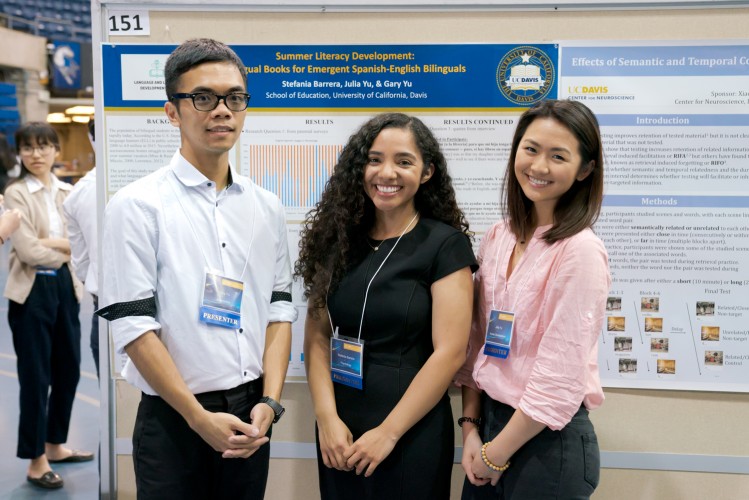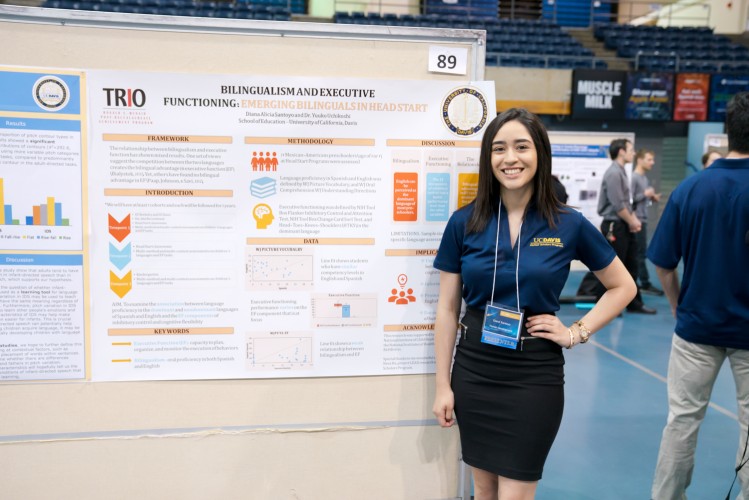Undergraduate Research Conference 4/26/2019
Great work from 11 of our undergraduate RAs!
Friday, April 26, 2019 at the ARC Pavilon.
Title: Bilingualism and Executive Functioning: Emerging Bilinguals in Head Start
Presenter: Diana Santoyo
The relationship between bilingualism and executive function has shown mixed results. Children’s metalinguistic awareness has been displayed as an advantage of bilingualism, which serves as indicators of executive function (EF) systems (Bialystok, 2015). Yet, others have found no bilingual advantage in EF (Paap, Johnson, & Sawi, 2015). The aim of this study is to examine the associationbetween language proficiency in the dominant and nondominant languages of Spanish and English and the EF components of inhibitory control and cognitive flexibility with emerging Spanish-English bilingual preschoolers enrolled in Head Start programs. In this study, bilingualism will be defined by performance on the Woodcock Johnson Picture Vocabulary, Oral Comprehension, and Understanding Directions, while EF will be measured with the NIH Tool Box and Head-Toes-Knees-Shoulders Task. Data is being collected from Mexican-American preschoolers attending Head Start programs in Northern California. Data will be analyzed to examine the relationship between bilingualism and executive function tasks. The findings from this study can help us understand the role of bilingualism on cognition. Implications for home literacy practices and classroom instruction will be discussed.
Title: How do Spanish-English and Cantonese-English Bilingual Children Differ in their Development of English Narrative Skills?
Presenters: Names: Jodie Sakazaki, Terry Huang, Tiffany Wei
Abstract: This longitudinal study investigated the differences in macro-level components of English oral narratives among a total of 40 bilingual children (16 Spanish-English and 24 Cantonese-English) who were enrolled in transitional bilingual educational programs. Children’s English narratives were collected by having them tell a story using Frog, Where are You?, a wordless picture book. The narrative quality was assessed using the Narrative Scoring Scheme (NSS), which measures children’s narratives along seven elements (introduction, character development, mental states, referencing, conflict resolution, cohesion, conclusion), each of which is scored holistically on a scale of 1–5. Scores from each category of the NSS were compared between Spanish-English and Cantonese-English children. Results showed that on average, narratives scores developed over the three years. Results also showed that Spanish-English children scored higher than Cantonese-English children on character development, cohesion, conclusion and significantly higher on mental states. Cantonese-English children scored higher than Spanish-English children on the introduction elements. The conclusions from this study may help inform educational strategies to best support language development among different groups of bilingual children.
Title: Summer Literacy Development: Bilingual Books for Emergent Spanish-English Bilinguals
Presenters: Stefania Barrera, Gary Yu, Julia Yu
Abstract: The population of emergent Spanish-English bilinguals is growing in the United States. However, these bilingual children from low-income environments are experiencing a decline in English skills over the summer. In this study, we will examine how bilingual children spend their summers. We will focus on the following questions: 1) How much Spanish and English do Spanish-English bilinguals hear and use during the summer? and 2) How do Spanish-English bilinguals spend their typical summer days? Then, we aim to identify an effective summer reading program that may help prevent summer literacy decline. We provided bilingual books to four children and conducted focus group interviews with their parents. Preliminary results suggest that language exposure in Spanish and English is varied. Our focus group interviews suggest that Spanish-English speaking children from low-income homes may not have access to literacy resources over the summer and, thus, are unable to further develop their literacy skills. However, both parents and children would actively engage in literacy activities over the summer if provided with the appropriate resources tailored to their interests and that accommodate for social factors that may limit their access to resources. The findings suggest that providing library resources to parents may be helpful.
Title: Interactions During Shared Book Reading: Spanish-English Bilingual Children and their Parents
Presenters: Naomi Reeley, Mayra Covarrubias, Paola Gutierrez, Cecilia Plascencia
Abstract: Past studies with preschoolers and younger, have shown that bilingual parents tend to read to their children in the language that is most spoken at home. Also, bilingual parents read in the language they are most comfortable reading in. Parents engaged their preschooler by pointing to illustrations that might relate to the child, providing yes/no questions, giving more descriptions, and providing positive feedback (Rodriguez, Hines,& Montiel 2009). The goal of this study is to understand how Spanish-speaking parents interact with older children, specifically with a kindergarten child while reading a bilingual book. The research questions are: (1) What languages do Spanish-speaking parents use with their Spanish-English bilingual children when reading bilingual books? (2) What are some strategies Spanish-speaking parents engage in when reading to their children? A total of 12 Spanish-speaking parent-child dyads were asked to read a Spanish-English bilingual book, Radio Man by Arthur Dorros together. Preliminary results show that parents tended to read mostly in Spanish. When the parent engaged, they would ask questions about the text and point to the illustrations. Results suggest that bilingual books provide opportunities for parents and children to read in a language that they feel most comfortable in.












